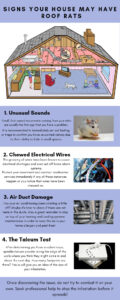
If you have mice or other rodents in your attic or crawl space, you’re familiar with the pitter-patter sound of feet on a wood floor. This is often your first indication of a rodent infestation, as your attic might already have several living in the residence. It’s important to block entry and quickly eradicate the population before it causes damage to your home or cause stress for your family. Here are a few hidden dangers of having rodents in your home:
1. Structural and Electrical Damage
Mice love to burrow, chew, and not only damage electrical wiring, but to the foundation and other structural features of your home as well. Also, rodents often create nests in places like air conditioning vents. If you begin to hear them moving around through the vents and walls too, especially at night, this could be a sign that your rodent problem is becoming widespread.
2. Disease and Odor
Rodents have historically caused wide-spread disease, take the European Bubonic Plague for example, and rodents still carry several very harmful diseases that humans can be susceptible to, such as salmonella. Both airborne and fecal bacteria can cause health problems for those who share space with rodents.
There’s also the issue of odor. If a rodent dies in a hard-to-reach area, your entire home will smell of decomposition. This is extremely unpleasant and is often caused by using poison to eradicate the colony. When a mouse eats a poison pellet or gel, it may take time for the animal to die. Wherever they’re living or hiding, they often die in that space, causing an unpleasant odor for several weeks. That being said, it is important that rodents are not only poisoned or trapped, but removed from the space as well.
What You Can Do to Prevent an Infestation
There are several substances and household items that attract mice. First and most obviously, mice are attracted to food that is easily accessible. To prevent this, seal all food in plastic or air-tight containers. Second, mice actively look for supplies that can be used for a nest, such as loose paper, cloth, tissue, and even cardboard. Keeping a tidy residence is essential to preventing a rodent infestation. If you suspect your home is susceptible to mice, your best defense is using plastic totes or off-site storage, rather than cardboard boxes or styrofoam, which can be easily shewed-through.
Defense: Rodent Proofing
As previously mentioned, there are two essential defense systems we recommend you use when rodent-proofing your home: sealing and eradicating.
First, seal all entry points. It’s important to consult a professional who can help you identify areas where the mice may be occupying, as mice can fit through a hole as small as the size of a nickel. While your first instinct may be to patch up ground and basement-level holes, your attic is also an essential area of your home to proof for rodent infestation. Pay close attention to areas of your roof that are close to tall plants or gates, as rodents may be able to climb and jump from them.
Second, trap the mice that remain in the home. There are several different types of solutions, including snap traps, sticky traps, and no-kill traps. While unpleasant, this is a necessary step to keeping your home rodent free.
Lastly, tidy-up clutter your home. You’ll likely find droppings in your living area. Throw away any food that shows evidence of mouse tamperings, like chew marks on boxes or bags.
Attic Construction
If you’re in the market for rodent decontamination services for your attic or crawl space cleaning service, check out Attic Construction in San Diego, an insulation installation and rodent proofing service. Specializing in repairs, installation, cleanup, and more, Attic Construction are experts in ensuring your home is adequately protected from mice and other rodents. Contact us for more information and a quote for rodent prevention or attic insulation services.


